The Semana Santa Easter Festival in Antigua, Guatemala
Article and photos by Sandra Kennedy
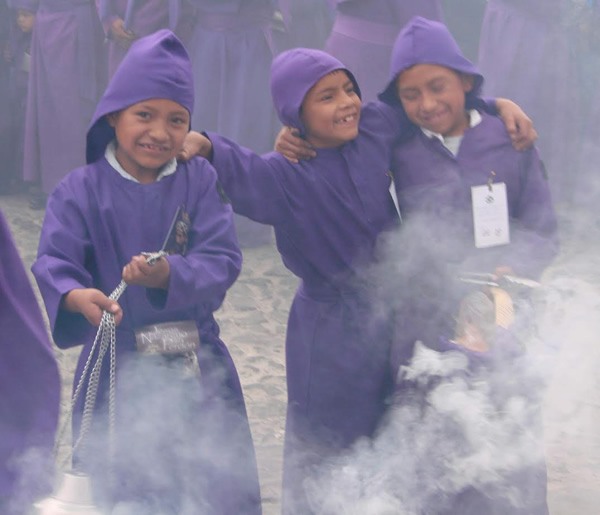 |
| Three boys carrying incense-holders during the Easter festival in Antigua. |
Pastel-colored homes, cobblestone streets, bougainvillea-covered walls and looming volcanoes offer the first glimpses of Antigua. The UNESCO World Heritage site embraces thousands of travelers wanting to experience this world-famous Catholic celebration commemorating the Passion, Crucifixion, and Resurrection of Jesus Christ.
Antigua, Guatemala comes alive with its annual “Semana Santa” Holy Week, held sometime between March 22 and April 23. The entire city participates in the solemn activities during the week with a joyous celebration on Easter. Spanish missionaries from Seville initiated this religious occasion during colonial times.
On Palm Sunday, andas (floats) with images of the Holy Virgin of Sorrow and Jesus of Nazareth, are carried on the shoulders of purple-robed devotees. The floats weigh up to 7,000 pounds with 50-100 curcuruchas (carriers) bearing their weight.
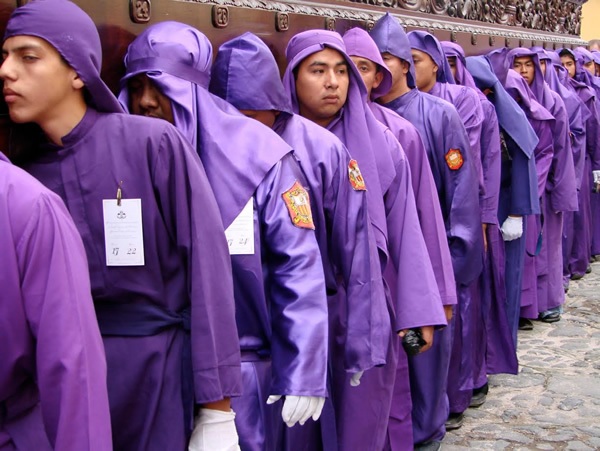 |
| Purple-robed carriers of a float (anda) during the Easter festival in Antigua. |
Funeral marching bands follow the floats, announcing themselves with sounds of slowly beating drums, clapping cymbals and deep-throated tubas. Thick incense creates a haunting, ghost-like fog. Crowds hush as the solemn procession passes by.
Monday through Thursday, similar processions parade through the streets in memory of Jesus’ final days. Devoted curcuruchas carry floats for a block, and then new carriers step in to carry them on to the next block. The ritual of carrying and transferring floats continues throughout the procession route, often lasting up to 12 hours. Standing room only crowds await each float’s church arrival at night.
On Good Friday, the participants dress in black. A float with a sculpture of Jesus carrying the crucifix leads crowds of mourners who pray silently and offer penance. In the afternoon, preparations are made for a mock trial and sentencing of Jesus Christ. Participants are dressed as Roman soldiers and even Pontius Pilate is represented. Eventually, floats covered with statues of the crucified Jesus come to rest at the church late in the night.
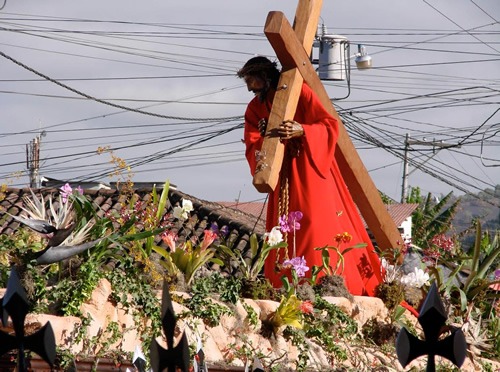 |
| Christ carrying the cross on a float during the Easter festival. |
Holy Saturday’s processions are dedicated to images of the Virgin Mary of Sorrow. Women dress in their finest outfits and often wear high heels. Young children walk under the anda while their mothers shoulder the immense float.
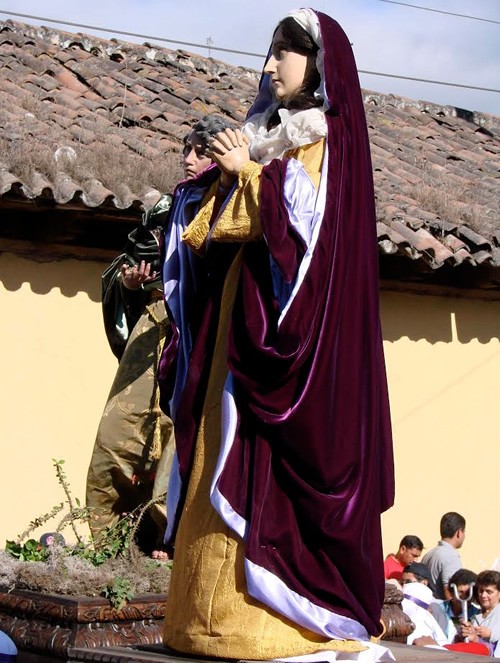 |
| Virgin Mary of Sorrow on a float shouldered
by women as their children walk underneath it. |
Easter Sunday is a day of rejoicing the resurrection of Christ. Fireworks, family meals, and celebrations continue throughout the day.
Some of the most remarkable aspects of Holy Week are the luxurious alfombras (Arabic for "carpet") adorning the cobbled streets between processions. Families and friends begin preparations weeks and months ahead of the festival to create these elaborate offerings.
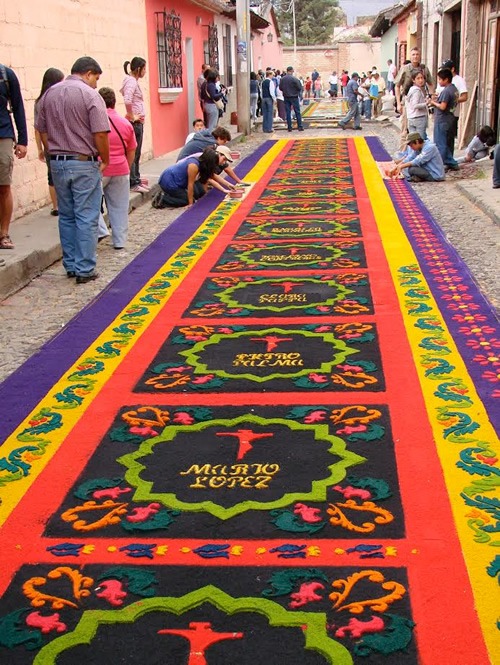 |
| Alfombras spread across the
streets of Antigua during the Easter festival as finishing
touches are added. |
Sand is spread over the cobblestones to level them. Next, dyed sawdust in hues of black, red, yellow, purple, blue, and green are pressed through intricately designed cardboard stencils. Flowers, seeds, plants, vegetables, and pine needles add the final touches to these temporary works of art. The carpets’ designs reflect biblical symbols, Mayan traditions, and scenes from nature.
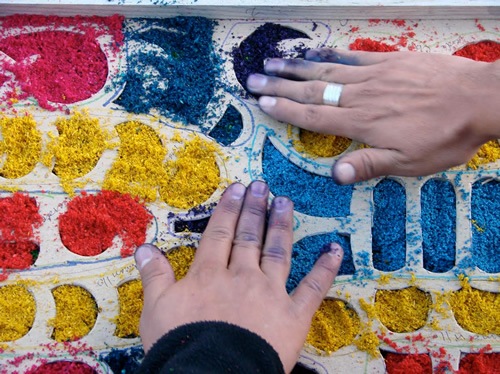 |
| Natives' hands at work finishing the design of the symbolic Alfombras seen above. |
Soon procession marchers and heavy floats trample the once-beautiful alfombras, leaving only jumbled messes and flowers. Often, more than one procession passes over them. Within hours, another carpet is created. It is their way to honor Christ’s death and pay penance.
“Semana Santa” (Saint week) is a passionate sensory experience that mingles Spanish and Mayan traditions. It is a profound experience and well worth the trip.
For More Information
If You Go
- Plan a year in advance, if possible, or join a tour group.
- Adventure Life Journeys is
one of a few tour groups for this Easter Festival. It has a nine-day trip with a local bilingual guide, small groups, and sustainable tourism practices. It includes the Easter Festival, ChiChicastenango and Solola Markets, as well as Lake Atitlan.
- Getting there: Numerous airlines fly into to Guatemala City’s La Aurora International Airport (GUA). If you arrive late at night, you may consider booking a hotel that offers shuttle service to the airport. Be sure to get an email confirmation. Plan with your hotel for a reliable shuttle to Antigua. It takes about an hour. Buses, rental cars and taxis are also available. It is best to go in the daytime.
- Getting around in Antigua: Taxis, buses and Asian style “tuk tuks” are available for short journeys. Walking is the most common way to explore Antigua.
- Bring along: Sunscreen, hats, camera, and good walking shoes
- Tourist Information: The office is on the southeast corner of the Parque Central (main park) and is a good starting point for information, or to pick up maps. Check
out their cultural notice board.
- Accommodations: There are numerous budget to luxury hotels. B&Bs and inns are also available. Use one of the websites below or google “Antigua Guatemala accommodations.”
- Banks: Most are located near the central park. Banco Quetzal appears to give the best exchange rate. Quetzals are the currency. Bring your passport. (Open: Mon-Fri 9 a.m.-5 p.m., Sat 9 a.m.-1 p.m.) ATMS are available, however remain vigilant of your surroundings when using them.
- Guatemala assistance & emergencies (INGUAT). Open 24 hours/ 7 days. Dial 1500 in Guatemala.
Useful Sites
|
Sandra Kennedy is a Freelance Travel Writer & Photographer based in Oregon. She is a member of the North American Travel Journalists Association and has contributed to many international and national publications. She specializes in South American travel.
|
